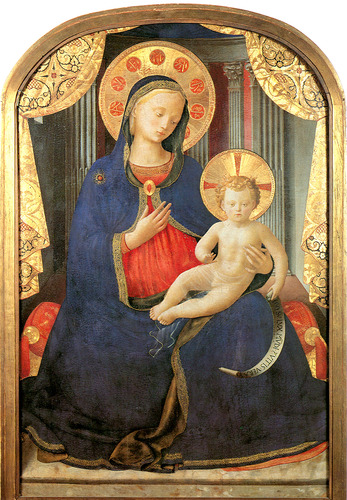
The Life of the Blessed Virgin Mary by Blessed Anne Catherine Emmerich
5. CAUSE OF THE FEAST OF THE NATIVITY OF MARY.
[On the evening of September 7 ^th, the vigil of the Feast of Mary's Nativity, Catherine Emmerich was unwontedly-- as she said, supernaturally--gay, although she felt ill at the same time. She was in an unusually lively and confidential mood. She spoke of extraordinary joy in all nature because of Mary's approaching birth, and said that she felt as if a great joy was awaiting her next day, if only this did not turn to sorrow. [55] ] There is such jubilation in nature: I hear birds singing, I see lambs and kids frolicking, and where Anna's house once stood the doves are flying about in great flocks as if drunk with joy. Of the house and its surroundings nothing now remains; it is now a wilderness. I saw some pilgrims, holding long staffs and their garments girt about them, with cloths wrapped round their heads like caps. They are going through this part of the country on their way to Mount Carmel. A few hermits from Mount Carmel live here, and the pilgrims asked them in amazement what was the meaning of this joy in nature? They were told that it was ever thus in that country on the eve of Mary's birth, and that it was probably there that Anna's house had stood. A pilgrim who had passed that way before had, they said, told them that this was first noticed a long time ago by a devout man, and that this had led to the celebration of the feast of Mary's Nativity.I now saw this institution of the feast myself. [56] Two hundred and fifty years after the death of the Blessed Virgin I saw a very devout man journeying through the Holy Land in order to seek out and venerate all the places connected with the life of Jesus upon earth. I saw that this holy man was given guidance from above, and often remained for several days in prayer and contemplation at different places, enjoying many visions and full of interior delight. He had for many years felt, in the night of the 7 ^th to the 8 ^th of September, a great joyfulness in nature and heard a lovely singing in the air; and at last, in answer to his earnest prayer, he was told by an angel in a dream that this was the birthnight of the Blessed Virgin Mary. He received this revelation on his journey to Mount Sinai or Horeb. It was told him at the same time that in a cave of the Prophet Elijah on that mountain was a walled-up chapel in honor of the Mother of the Messiah, and that he was to inform the hermits living there of both these things. Thereupon I saw him arriving at Mount Sinai. The place where the monastery now stands was already at that time inhabited by isolated hermits, and just as precipitous on the side facing the valley as it is now, when people have to be hoisted up by means of a pulley. I saw now that upon his announcement the Feast of the Nativity of the Blessed Virgin was first celebrated here by the hermits on September 8 ^th about A.D. 250, and that its celebration spread later to the Universal Church. I saw, too, how he and the hermits looked for the cave of Elijah and the chapel in honor of the Blessed Virgin. These were, however, very difficult to find among the many caves of the Essenes and of other hermits. I saw many deserted gardens here and there near these caves, with magnificent fruit trees in them. After praying, the devout man was inspired to take a Jew with them when they visited these caves, and was told that they might recognize as the cave of Elijah the one that he was unable to enter. I saw thereupon how they sent an aged Jew into the caves, and how he felt himself thrust out of the narrow entrance of one of them, however much he tried to force his way in. In this way they recognized it as the cave of Elijah. They found in it a second cave, walled-up, which they opened; and this was the place where Elijah had prayed in veneration of the future mother of the Savior. The big, beautifully patterned stones which made the wall were used later for building the church. They also found in the cave many holy bones of patriarchs and prophets, as well as many woven screens and objects of earlier worship. All these were preserved in the church. I saw much of Mount Horeb on this occasion, but have forgotten it again. I still remember that the place where Moses saw the burning bush is called in the language of the place The Shadow of God', and that one may walk on it only with bare feet. I also saw a mountain there entirely of red sand, on which, however, very fine fruit trees grew.
CONTENTS | NEXT | FOOTNOTESCopyright ©1999-2023 Wildfire Fellowship, Inc all rights reserved

 Keep Site Running
Keep Site Running